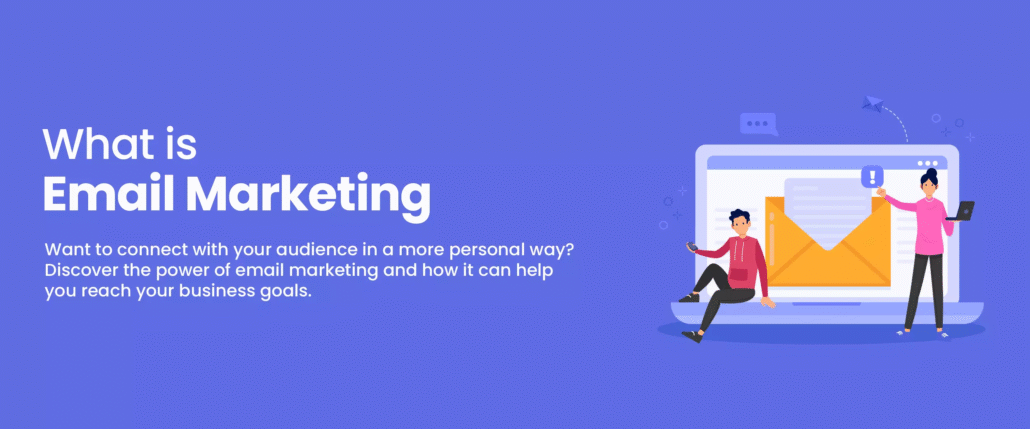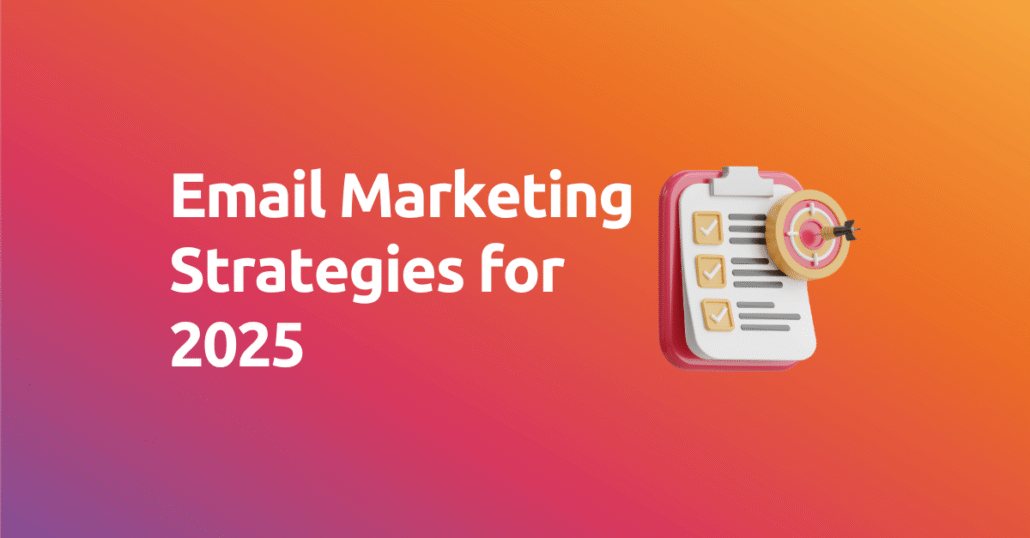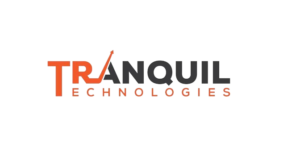“What is Email Marketing and How Does It Work in 2025?”
What is Email Marketing?

Email marketing is a digital marketing method where businesses send emails to customers or subscribers to share updates, promotions, or useful information. It helps companies build relationships, increase brand awareness, and drive sales by reaching people directly in their inbox.
In today’s time, email marketing is more advanced with automation, AI-driven personalization, and analytics that track customer behavior. This makes it one of the most effective and affordable ways to connect with an audience, especially compared to other marketing channels.
Types of Email Marketing
Email marketing isn’t just about sending one type of message — different campaigns are designed to achieve different goals. Here are the most common types:

- Newsletter Emails – These provide regular updates, news, or blog content to subscribers. They help in keeping the audience informed and engaged with the brand.
- Promotional Emails – Focused on offers, discounts, or product launches. Their main goal is to boost sales and encourage immediate action.
- Welcome Emails – Sent to new subscribers right after they sign up. These emails create the first impression and often include brand introductions or exclusive offers.
- Transactional Emails – Automated messages triggered by customer actions, such as order confirmations, receipts, or shipping updates. They build trust by providing important information.
- Re-engagement Emails – Target inactive subscribers with reminders, special deals, or feedback requests to win back their attention.
- Seasonal or Holiday Emails – Sent during festivals, holidays, or special events. These help brands connect with customers emotionally and encourage purchases during high-demand periods.
✅ By using a combination of these email types, businesses can cover all stages of the customer journey — from awareness and engagement to sales and retention.
Advantages of Email Marketing
- Cost-Effective
Unlike traditional marketing (TV, print, or billboards), email marketing requires very little cost. With just an email automation tool, businesses can reach thousands of people at once without spending heavily. - Direct & Instant Communication
Emails land directly in a customer’s inbox, making it one of the fastest ways to share updates, offers, or important information. This ensures your message is seen quickly. - Personalization & Targeting
Marketers can segment their audience and send personalized emails based on user behavior, interests, or purchase history. Personalized emails increase engagement and conversion rates. - Measurable Performance
Every campaign can be tracked with metrics like open rates, click-through rates, bounce rates, and conversions. This helps businesses improve their future campaigns. - Automation Saves Time
With tools, businesses can automate welcome emails, cart reminders, and follow-ups. This reduces manual work and keeps customer communication consistent. - High ROI (Return on Investment)
Studies show that email marketing offers one of the highest ROIs among digital channels, meaning the money spent generates great returns.
Disadvantages of Email Marketing
- Spam & Deliverability Issues
If emails are not well-targeted or relevant, they may land in the spam folder. This reduces visibility and impacts performance. - Overcrowded Inboxes
Customers often receive dozens of promotional emails daily. If your subject line or content isn’t engaging, it may get ignored or deleted. - Unsubscribes & Audience Loss
Sending too many or irrelevant emails can frustrate users, leading them to unsubscribe permanently. - Design & Compatibility Challenges
Emails need to look good on all devices (desktop, mobile, tablet). A poor design may discourage readers from engaging. - Legal & Privacy Compliance
Businesses must follow laws like GDPR or CAN-SPAM, which require permission-based marketing. Not following rules can lead to fines or reputational damage. - Dependence on Good Practices
Success depends heavily on quality content, timing, and audience segmentation. A weak strategy can make campaigns ineffective.
How to Get Started with Email Marketing
Starting email marketing may feel overwhelming, but with the right steps, it becomes a simple and effective strategy. Here’s how beginners can get started:
- Define Your Goal – Decide what you want to achieve: brand awareness, more website traffic, or higher sales.
- Choose an Email Marketing Platform – Select software like Mailchimp, HubSpot, or ActiveCampaign to create and manage campaigns.
- Build an Email List – Collect subscribers through website sign-up forms, landing pages, or lead magnets like free eBooks, discounts, or newsletters.
- Segment Your Audience – Group subscribers based on their interests, location, or purchase behavior to send more relevant emails.
- Create Engaging Content – Write compelling subject lines, design mobile-friendly emails, and focus on valuable content instead of just promotions.
- Set Up Automation – Use workflows to send welcome emails, birthday messages, or cart reminders automatically.
- Test and Improve – Track open rates, clicks, and conversions. Experiment with subject lines, designs, and send times to see what works best.
By following these steps, businesses can build a strong email marketing foundation that delivers consistent engagement and long-term results.
Best Tools and Platforms for Email Marketing in 2025
- Mailchimp
One of the most popular platforms, Mailchimp is beginner-friendly and offers automation, audience segmentation, and AI-driven recommendations. It’s great for small to medium businesses. - HubSpot Email Marketing
HubSpot is known for its advanced CRM integration. It allows businesses to run personalized email campaigns, track performance, and manage leads all in one place. - Constant Contact
Ideal for small businesses, this tool offers easy-to-use templates, list management, and event marketing features. It’s also good for growing subscriber bases. - Sendinblue (Now Brevo)
A cost-effective tool that provides email marketing, SMS campaigns, and marketing automation. It’s great for businesses looking to combine email with multi-channel marketing. - ActiveCampaign
Known for its powerful automation workflows, ActiveCampaign helps businesses personalize email journeys based on customer behavior, making it ideal for higher conversions. - GetResponse
This platform offers email marketing, landing pages, and webinar hosting — a complete solution for businesses that want more than just email campaigns. - Campaign Monitor
Known for its beautiful email templates and easy design tools, Campaign Monitor is perfect for businesses that focus on visually appealing newsletters. - MailerLite
A budget-friendly tool that still offers automation, A/B testing, and drag-and-drop builders. It’s especially popular among startups and bloggers. - Klaviyo
A top choice for eCommerce businesses. It integrates well with Shopify, WooCommerce, and Magento, helping brands send highly targeted product recommendations and abandoned cart reminders. - Zoho Campaigns
A good option for businesses already using Zoho CRM. It provides smooth integration, automation, and detailed analytics at an affordable price.
Best Email Marketing Strategies in 2025

- Personalization Beyond First Name
Simply using the subscriber’s name is no longer enough. In 2025, personalization means recommending products, sending content, and offering deals based on browsing history, purchase patterns, and location. - Segment Your Audience
Instead of sending the same email to everyone, divide your audience into groups (new subscribers, loyal customers, inactive users, etc.). Segmented campaigns usually get much higher open and conversion rates. - Mobile-Optimized Emails
Since most people check emails on smartphones, mobile-friendly designs with short text, clear CTAs (Call-to-Actions), and responsive layouts are essential. - Interactive Content
Adding polls, surveys, GIFs, and clickable elements inside emails makes them more engaging and improves click-through rates. - Automation & AI
Use automation for welcome emails, cart abandonment reminders, and re-engagement campaigns. AI tools can also suggest the best time to send emails for maximum open rates. - Compelling Subject Lines
Subject lines decide whether your email gets opened or ignored. Keep them short, relevant, and curiosity-driven. A/B testing different subject lines is a must in 2025. - Value-First Approach
Don’t just sell in every email. Mix promotional content with valuable tips, guides, or updates. This builds trust and reduces unsubscribes. - Consistency Without Overloading
Send emails regularly (weekly or bi-weekly), but avoid spamming. A balanced frequency keeps subscribers engaged without overwhelming them. - Focus on Data Privacy
With stricter privacy laws, always use opt-in forms and provide easy unsubscribe options. Transparency improves customer trust. - Testing & Analytics
Continuously test subject lines, content formats, CTA buttons, and sending times. Use analytics to refine your strategy for better performance.
📌 Email Marketing for Small Business
Email marketing is one of the most effective tools for small businesses in 2025 because it helps them connect with their audience directly, without spending huge budgets on ads. Here are the main advantages explained in detail:

- Cost-Effective – Unlike paid ads on Google or social media, email marketing requires very little investment. With a simple email platform, small businesses can reach hundreds or thousands of customers at once.
- High ROI – According to industry reports, email marketing continues to provide one of the highest returns compared to other digital channels. A well-structured email campaign can bring back old customers and generate repeat sales.
- Customer Retention – Small businesses can keep their customers engaged with regular newsletters, product updates, and seasonal offers. This helps in building long-term relationships and trust.
- Personalization – Emails can be customized for each segment of your audience. For example, loyal customers can receive exclusive discounts, while new subscribers can get a welcome offer. This level of personalization is hard to achieve with traditional marketing.
- Automation – With modern email platforms, small businesses can automate their campaigns. Welcome emails, abandoned cart reminders, and birthday greetings can all be set up once and run automatically, saving time and effort.
- Competes with Big Brands – Even without a large budget, small businesses can create professional-looking campaigns. By focusing on relevance and personalization, they can compete effectively with bigger players in the market.
- Mobile-Friendly Reach – In 2025, most people check their emails on smartphones. This gives small businesses the opportunity to stay connected with customers anytime, anywhere.
How to Improve Email Open Rates in 2025
Getting subscribers to open your emails is the first step toward a successful campaign. In 2025, inboxes are crowded, so brands need smart strategies to stand out. Here are the best ways to improve email open rates:
- Craft Attention-Grabbing Subject Lines
Keep subject lines short, clear, and curiosity-driven. Use personalization and A/B testing to see which style works best with your audience. - Personalize Your Emails
Instead of generic blasts, use subscriber data (name, interests, past purchases) to send content that feels relevant and personal. - Optimize Send Times with AI
Use tools that analyze subscriber behavior and send emails at the time they’re most likely to open them. Timing plays a big role in open rates. - Segment Your Audience
Divide your email list into groups like new subscribers, loyal customers, or inactive users. Targeted emails perform better than one-size-fits-all campaigns. - Improve Preheader Text
Many people decide to open an email after reading the preview text. Use this space wisely to add context or create curiosity. - Maintain Consistency
Send emails regularly (weekly, bi-weekly, or monthly) so your audience expects your content. Avoid spamming, as it can lead to unsubscribes. - Avoid Spam Triggers
Words like “Free!!!” or too many symbols can push your emails into spam folders. Keep your emails clean, trustworthy, and professional. - Mobile-Friendly Design
Since most users open emails on smartphones, ensure your emails load fast and display properly on mobile devices. - Re-Engagement Campaigns
For inactive subscribers, send special offers, surveys, or “We miss you” campaigns to bring them back. - Test and Analyze
Track open rates, click-through rates, and unsubscribe rates. Continuous testing helps refine your strategy over time.
AI-Powered Email Marketing in 2025
Artificial Intelligence (AI) is transforming the way businesses run email campaigns. Instead of relying on guesswork, AI helps marketers make smarter decisions and deliver highly personalized experiences. Some of the key uses of AI in email marketing include:
- Personalization at Scale – AI analyzes customer data (interests, purchase history, browsing behavior) to send emails that feel individually tailored.
- Smart Segmentation – Instead of broad groups, AI creates micro-segments, ensuring every subscriber gets the most relevant content.
- Optimal Send Times – AI predicts when each user is most likely to open an email, improving open and click-through rates.
- Content Recommendations – Just like Netflix or Amazon, AI suggests the right products, blogs, or offers to include in each email.
- A/B Testing Automation – AI runs tests on subject lines, layouts, and CTAs automatically, then applies the winning version to boost performance.
- Predictive Analytics – By studying past behavior, AI forecasts what a user might want next, helping businesses plan future campaigns effectively.
In short, AI-powered email marketing in 2025 makes campaigns smarter, faster, and more impactful, helping businesses connect with customers on a deeper level while saving time and resources.
Trends and Future of Email Marketing in 2025
- AI and Automation – Smart tools help predict customer behavior, send emails at the right time, and improve personalization.
- Interactive Emails – Features like polls, surveys, product carousels, and shopping options inside emails are becoming popular.
- Hyper-Personalization – Content will be based on user behavior, purchase history, and preferences, not just their name.
- Mobile Optimization – Most users open emails on smartphones, so responsive and fast-loading designs are the future.
- Data Privacy and Trust – Customers prefer brands that respect privacy and avoid spammy practices.
- Voice and Smart Devices – Future emails may integrate with voice assistants and smart devices for quick actions.
- Content Quality Over Quantity – Brands focusing on valuable, engaging content will see better long-term results.
Email Marketing Software
Email marketing software is a tool that helps businesses create, send, and manage email campaigns effectively. Instead of sending emails manually, these platforms automate the process and provide powerful features to increase engagement. They allow marketers to design professional emails with drag-and-drop editors, manage subscriber lists, and track performance with detailed analytics.
Most email marketing software also comes with automation workflows—for example, sending a welcome email when someone subscribes, or a reminder when a customer abandons their cart. Advanced tools include AI-powered features such as personalized recommendations, predictive send times, and automatic subject line testing to improve results.
Some popular email marketing software in 2025 include:
- Mailchimp – Easy to use, great for small businesses.
- HubSpot Email Marketing – Integrated with CRM for better targeting.
- ActiveCampaign – Strong in automation and personalization.
- ConvertKit – Popular among creators and bloggers.
- Sendinblue (Brevo) – Affordable with good automation features.
In short, email marketing software makes campaigns faster, smarter, and more effective, helping businesses of all sizes connect with their audience and increase conversions.
Conclusion
Email marketing in 2025 continues to be one of the most powerful tools for businesses to connect with their audience. From understanding the basics and different types of email marketing to exploring the advantages, disadvantages, and modern strategies, it’s clear that email remains a cost-effective and high-conversion channel. With the right tools and platforms, businesses can automate campaigns, personalize messages, and track results in real time.
For small businesses, email marketing offers an affordable way to build trust and grow customer relationships. Improving open rates with better subject lines, segmentation, and AI-driven personalization makes campaigns more impactful. Looking ahead, trends like AI-powered automation, predictive analytics, and advanced email software will shape the future of this marketing channel.
In short, whether you are just getting started or already running campaigns, focusing on smart strategies, the right platforms, and consistent engagement can help you unlock the true potential of email marketing in 2025 and beyond.

Leave a Reply
Want to join the discussion?Feel free to contribute!